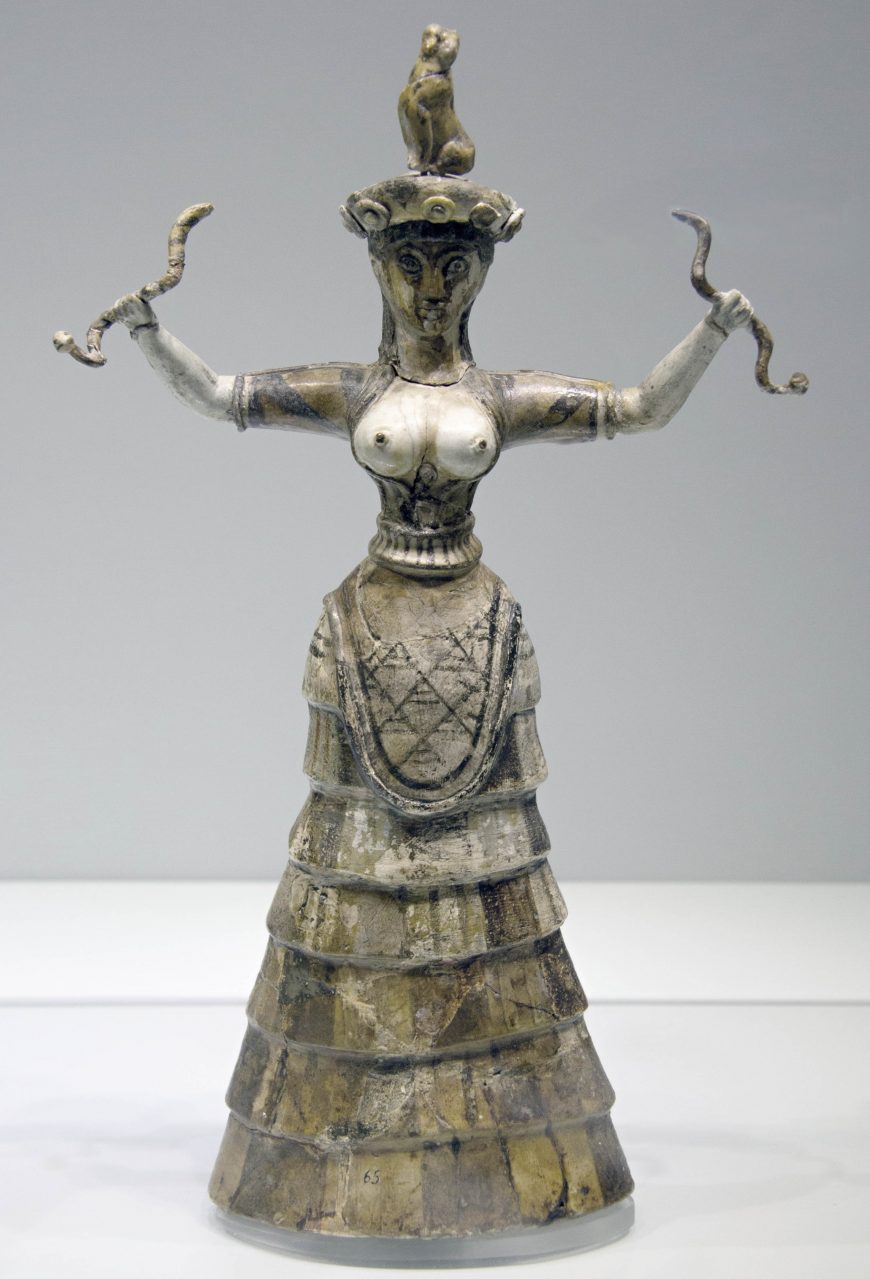Post Modern Times
shotgun wedding to the face
a marriage between
Heaven
and Hell - where the planetary brains splatter
out the skull onto the celestial cathedral walls
of a baby universe
in awe of
infinite probabilities
total
annihilation
She came at me
sliding a coffin with one hand and swinging a
snake in the other
dressed
in white straps and buckles
a bridal gown made up of straight-jackets
without reflective science or revelation laden
mysticism to save me
floundering knowledge set against this stark
portrait of companionship distancing itself from romantic salvation and
meditative solitude, BREAK CLASS IN CASE OF EMERGENCY, (a programmable sanity)
like
glass - an imaginary border
shattering in the mind's eye,
but aren't we all just human
with the lonely hunger for the comfort of others
with the greatest of expectations
in a
realm of hollow expenses?

The Snake Goddess -- Halvor Bagge
Kriti (Krete in ancient Greek) was a Turkish possession that was inhabited by a mostly Greek-speaking Christian population. In 1877 Minos Kalokairinos, the youngest son of a rich landowner, began excavating ancient ruins on his father's property, but the authorities forced him to halt the work in 1878 after the island was granted autonomy. The government did not want any possible artifacts to be removed to Istanbul, so it encouraged foreigners to apply for a firman to excavate but only after buying the site, while the native owners were advised to charge so much money that no one would think it worthwhile. William James Stillman, an American journalist who had helped train Arthur Evans as a war correspondent in the Balkans in 1877, sought to take over the excavation from Kalokairinos but was unable to obtain the firman; he was the 1st to label the partly-uncovered walls "labyrinthine," after the Labyrith that Daedalus had constructed to house the Minotaur. (In 1907 Kalokairinos would sue Evans for taking a field without payment, excavating it without permission, and illegally removing antiquities found there from the country, but he woud die before the case was settled.) In 1889 the Turks reneged on the 1878 agreement. In 1894 Evans became intrigued by the idea that the script engraved on some stones he had bought might be Cretan, and arranged to acquire 1/4 of the site on behalf of the "Cretan Exploration Fund," of which he was the only contributor, with an option to buy the rest later. But the Christian Cretans revolted in 1895. Austria-Hungary, France, Germany, Italia, Russia, and the UK sent warships to restore order in February 1897 to restore peace, bombarded insurgent positions, occupied key locations, and established a blockade of Crete and key ports in Greece, thus ending organized fighting by the end of March. But Greece sent military forces to support the Cretans, provoking a disastrous war against Turkey, though the Greeks and Cretans gained control over most of the island. The UK, France, Italia, and Russia forced the Greeks to withdraw and made the Turks halt their offensive against Greece. In August 1898 a Turkish mob massacred hundreds of Cretan Greeks and murdered the British consul, his family, and 17 British soldiers in Kandiye, leading to the international force's expulsion of all Turkish forces from Crete in November. The son of Georgios I of Greece arrived on 9 December to take office as the hypatos harmostes (high commissioner).
ReplyDeleteAlthough the island was technically still part of Turkey, the Greeks were in charge under international supervision until 1908. Kandiye was part of what Evans called "the Turco-British regime" and renamed "Heraklion", after the Roman port of Heracleum ("Heracles' city"), whose exact location is unknown. Evans also coined the term "Minoan," derived from the mythical king Minos to designate the Bronze Age culture that flourished in the Aegean sea from ca. 2700 to ca. 1450 BCE, Europe's 1st advanced civilization. Evans bought the rest of the ruins, hired 2 foremen and 32 diggers, and began work on excavating Knossos, named after ancient Greek references to the major city of Kriti, in March 1900. Even before he began excavation he had argued that a great mother goddess had been worshiped in the pre-Classical Greek world. After digging out the entire western wing of the complex he called a “palace,” in 1903 he conducted a secondary exploration under the paving stones; just south of the "Throne Room" he discovered 2 stone-lined pits (the "Temple Repositories") containing a wide variety of mostly broken items, including the "Snake Goddess," his anticipated mother goddess. Many images of elite Minoan women, perhaps priestesses, look very much like this figurine, but there is no evidence of what a Minoan goddess might have looked like, and the image of a woman taming snakes is entirely unique to the 2 statuettes found in the Temple Repositories. (A nearly complete figurine found there had snakes slithering up both of her arms.) The Snake Goddess lacked a head and 1/2 of her left arm, and the right hand held a short, wavy, striped stick which Evans interpreted as a snake. He worked with Danish artist Halvor Bagge to create a head and a matching left arm and "snake," and to put the faience hat and cat found in the Temple Repositories on her head (though they have no parallel in any image of a Bronze age woman). After years of suffering from malaria and deeply in debt, Evans stopped his initial work on the site.
ReplyDelete